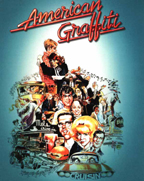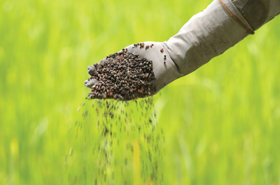The hit movie, American Graffiti, filmed in Modesto and Petaluma, California is one of the most influential of all teen films. It depicts multiple characters going through a coming of age, dealing with decisions to attend college or reside in a small town in the early 1960’s. Songs and music greatly influence the movie and are at the heart of the film as Dee Jay, Wolfman Jack, spins records of 41 tunes from various artists on the radio throughout the film.
George Lucas wrote each scene with a particular song in mind as its musical backdrop. The cost of licensing the 75 songs Lucas originally wanted was one factor in United Artists’ ultimate decision to reject the script; the studio also felt it was too experimental — “a musical montage with no characters.” Lucas co-wrote and directed the film that was finally produced by Universal after several other film producers turned it down. This was the first time a feature film of recorded musical selections (due to a low budget) was made. (United Artists also passed on Star Wars which Lucas shelved for the time being.)
American Graffiti depicts teenagers’ relationship with hot rod cars and their obsession with radio. Disc Jockey, Wolfman Jack’s broadcasts, with his mysterious and mythological faceless voice, ties the film together. Richard Dreyfuss’s character catches a glimpse of the mysterious Wolfman in a pivotal scene in the movie.
Prominent in American Graffiti was “cruising the strip.” This brought back memories when I was in high school in the fifties. On Friday and Saturday nights, we would “drag the main,” in our “cool cars,” blasting music on the radio, on Main Street in Walnut Creek. It was a ritual that lasted for many years – part of a rite-of-passage, as depicted in the film.
Some of the, now-nostalgic, songs played in the film are Rock Around The Clock by Bill Haley & the Comets; 16 Candles by The Crests; Runaway by Del Shannon; Why Do Fools Fall in Love by Frankie Lymon & The Teenagers; Fanny Mae by Buddy Holly, At the Hop and She’s So Fine by Flash Cadillac & The Continental Kids; The Stroll by The Diamonds; See You in September by The Tempos; Surfin Safari by The Beach Boys; The Great Imposter by The Fleetwoods; Almost Grown by Chuck Berry; Smoke Gets in Your Eyes by The Platters; The Book of Love by The Monotones; The Great Pretender by The Platters; Little Darlin by The Diamonds; Peppermint Twist by Joey Dee and the Starlighters; Ain’t That a Shame by Fats Domino; Johnny B. Goode by Chuck Berry and I Only Have Eyes for You by The Flamingos.
In its purest form, Rock & Roll music has three chords, a strong, insistent back beat and a catchy melody. Early Rock & Roll drew from a variety of sources, primarily Blues, Rhythm & Blues, Country, Gospel, Traditional Pop, Jazz and Folk. These influences combined in a simple, blues-based song structure that was fast, danceable and catchy. The first wave of rock & rollers were chuck Berry, Elvis Presley, Little Richard, Jerry Lee Lewis, Buddy Holly, Bo Diddley, Bill Haley, Gene Vincent, The Everly Brothers and Carl Perkins, among many others. These rockers set the template for Rock & Roll that was followed over the next four decades.
As the late fifties gave way to the early sixties, the rockabilly stars of the previous decade – the Everlys, Elvis and Roy Orbison, to name a few, were still having hits, but the older pop-music stars were fading away as they struggled to find material that would click with this new and energetic generation of kids. Pop music gradually became controlled by new young vocal groups, taking their power from a combination of the performer’s charisma along with the songwriting talents of the production team, who operated behind the scenes. Eventually rock artists came to be expected to write and even produce their own songs, becoming responsible for everything about how their records sounded.
The music of the late fifties, as with society in general, morphed into the early sixties without too much alteration. The films’ 1962 setting represents nearing an end of an era in American society and pop culture.Rock & Roll music as well as the teen culture of the late fifties and early sixties was obviously very different than it is today. In just a few short years the society we knew then was about to change, rather drastically, never to return to those relatively halcyon days of the past. Growing up in suburbia (Lafayette) I was a teenager in the fifties and a young man in the sixties. At times it was rather disconcerting going from the calm fifties to the sometimes tumultuous sixties that occurred during my high school and undergraduate college days.
The advent of the 1960’s ushered in a new era in contrast to the comparative quiescence of the 1950’s. A new president was elected, the first president born in the 20th century. The hopes of many were dashed three years later with the assassination of John F. Kennedy. The Vietnam War unfortunately split the country almost in half and prompted many anti-war marches and rebellious acts. The counterculture movement was just around the corner.
Locally, the first onset of the free-speech movement was being acted out on the campus of the University of California, Berkeley by Mario Savio and others. It quickly spread across the country. It didn’t take long for some people to start calling Berkeley – “Berserkly.” These things and more had a lasting effect upon the country, socially and culturally. Thus, modern music today reflects a lot of this change.
The music associated with American Graffiti will live on in the annuals of modern American music and in the hearts and minds of those who experienced it live – and hopefully for generations to come.
Mark your calendar for the Danville Community Band’s Annual Spring Concert, Sunday, June 2, 2013 at 4 p.m., Lesher Center for the Arts in Walnut Creek. For reservations call 925-943-SHOW (7469)
Please submit your questions and comments to banddirector01@comcast.net Visit our website at www.danvilleband.org for up-to-date information about the Danville Community Band.

![137598284 [Converted] copy](https://aliveeastbay.com/wp-content/uploads/2013/05/137598284-Converted-copy.jpg)

